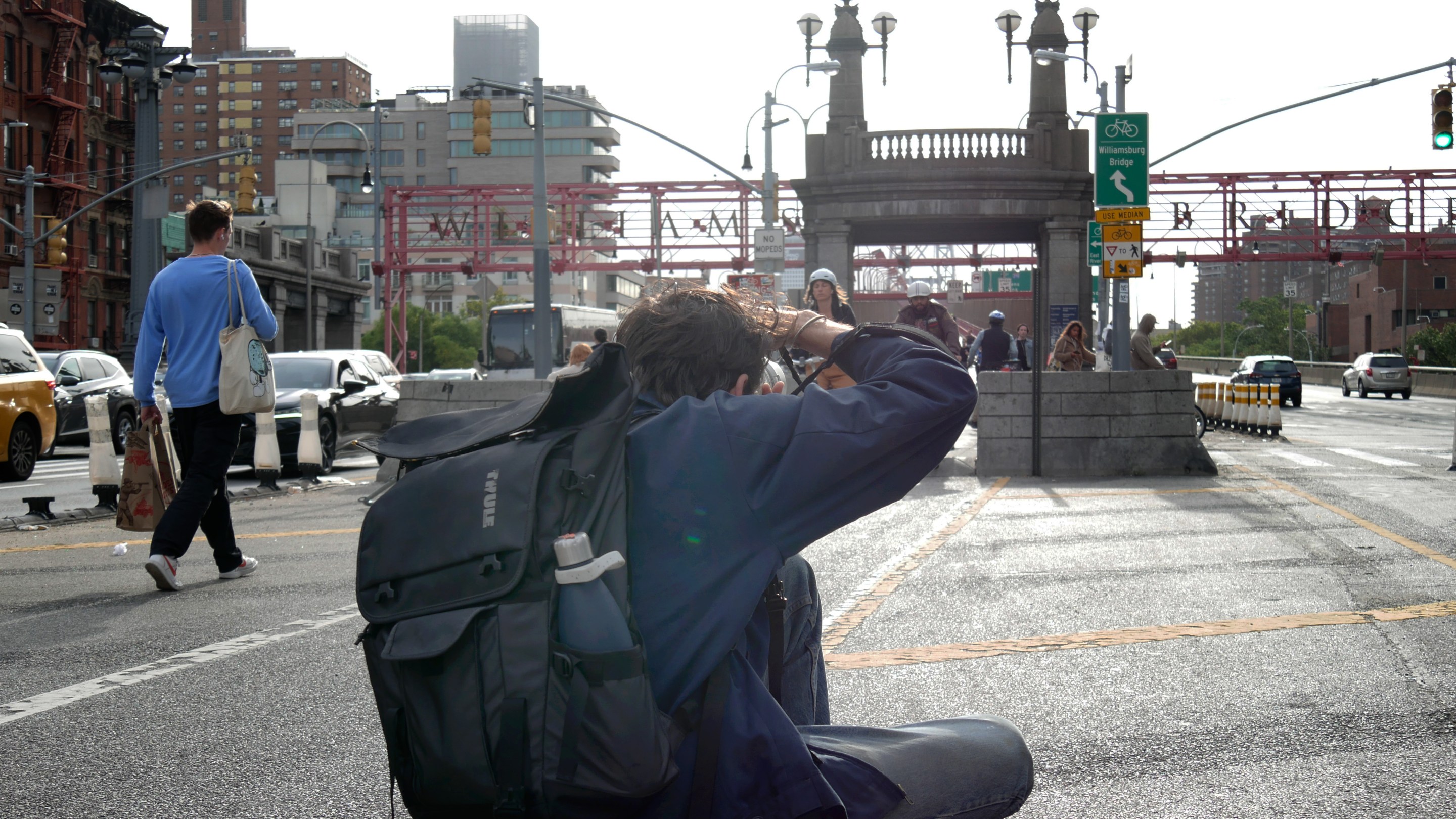The harrowingly narrow concrete-flanked off-ramp for cyclists at the Manhattan end of the Williamsburg Bridge forms the perfect frame for one local photographer's candid shots of Gotham's two-wheelers.
Unfortunately for everyone except lensman Adam DiCarlo, the city's plans to fix the dangerous, unfriendly bridge gateway are years from coming to fruition.
A record number of Manhattan-bound cyclists on Citi Bikes, single-speeds, road bikes and kid-carrying-cargos zoom down the bridge each day before funneling single-file through a narrow concrete ramp that provides the only designated connection west via the Delancey Street protected bike lane.
The mix of cyclists and pedestrians coming and going in every direction as the cyclists line up to head Delancey is the ideal muse for DiCarlo, who posts his photos on the Instagram account @ridersnyc.
“I love the image and how much of a dissection of the city that you can really see," DiCarlo told Streetsblog on a visit to the bridge's Manhattan terminus earlier this week.
"So many different types of people go through that one spot. It's kind of nice to keep the format the same and then just have the subject change.”
The Williamsburg Bridge has the highest bike ridership of the city's four East River Bridges — over a million and a half riders since the start of the year, an all-time record, with a seasonal peak of 277,966 riders in June, according to DOT bike counts.
The increase in cycling (and other forms of micro-mobility) has brought more traffic to the bridge and more interactions among those using it — for better and for worse. The crush for space has consequences: Since 2018 there have been three severe injuries involving pedestrians and two involving cyclists in the entrance/exit area, according to DOT. Many more likely went unreported.
DiCarlo, who spends multiple days a week sitting at the base of the bridge watching cyclists move in and out of the narrow gate, has seen crashes and close-calls. He likes the framing the design gives his photographs, though he knows it makes little sense.
If you are heading to Brooklyn from the Delancey Street two-way protected bike path, your lane splits with the west-bound traffic and takes a right, into the crosswalk. There is then a 90-degree turn between narrow bollards to continue up the bridge's hill. All the while, pedestrians are standing in the crosswalk and other cyclists, who opt to use the off ramp to avoid the awkward turn, are flying in your direction.
“I feel like it's only a matter of time before this is really protested in some way because it's really just common sense to not have it be a bottleneck,” said DiCarlo. “I'm happy to take advantage while I can. There's a bunch of chaos, but it's also really fun.”
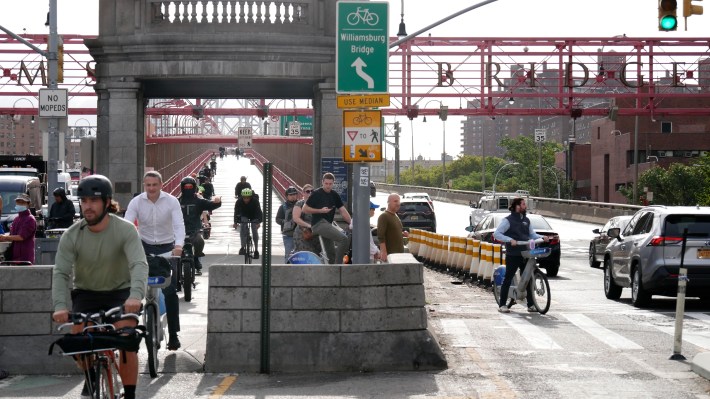
DiCarlo began taking photos from this spot last October. Now, a year later, he sees his body of work as representative of what it means to be a New Yorker. He hopes to turn the photos into a coffee table book so people can flip through and see the variety of characters that come off the bridge each morning.
The bridge remains a source of joy for the photographer. Growing up in Manhattan, he frequently used the span to bike home from Brooklyn. He recalled the freedom and payoff of the west-bound hill and the small jump created by the change in elevation.
"The bridge is just the mouth of the city, in a lot of ways, it's a great way to see what's going on,” said DiCarlo. “I’ve fallen in love with interacting with people every single morning.”
Still, the narrow bottle neck at the end of a fast descent is not a good design, and causes problems for cyclists and pedestrians who are trying to safely use the high-traffic area.
City officials last year announced plans to build out Delancey Street's protected bike lane and improve the entrance to the bridge — but the project's completion is still several years away.
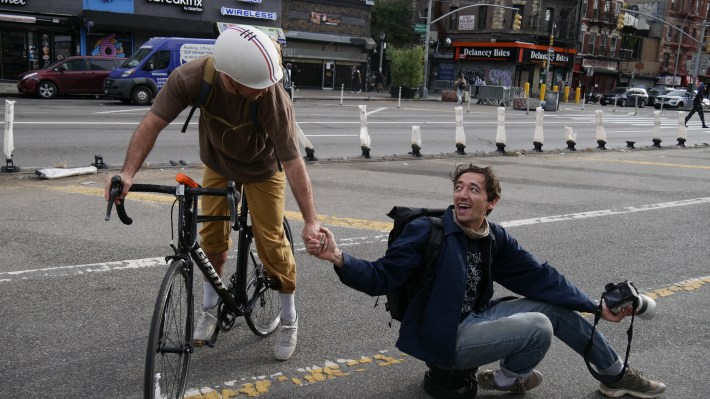
On Tuesday morning as DiCarlo snapped pics, a cyclist and an e-scooter rider collided at the site — highlighting the bridge’s glaring struggle to meet the surging demand: A cyclist veered right to get on the “on-ramp” to the bridge. At the same time a scooter cut across the two way bike lane, trying to get to Clinton Street without dealing with the bridge exit. The result was a minor crash, other bridge descenders luckily were able to veer out of the way and DiCarlo helped the cyclist up.
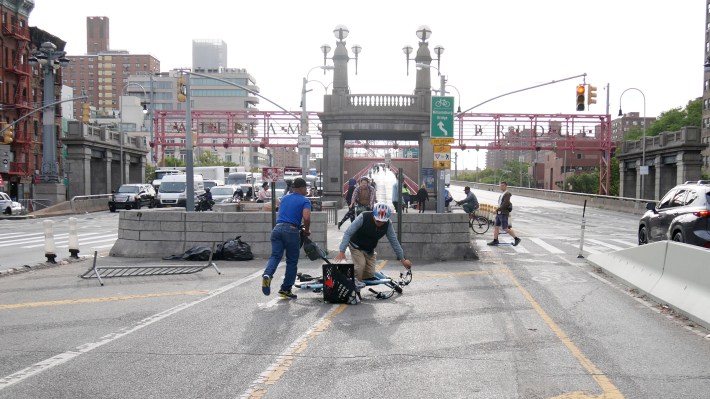
At another point, a rider with a cargo bike had to wait to go for traffic coming off the bridge to clear so she could go through the small opening to get back to Brooklyn because her bike can’t make the 90-degree turn for those entering the bridge:
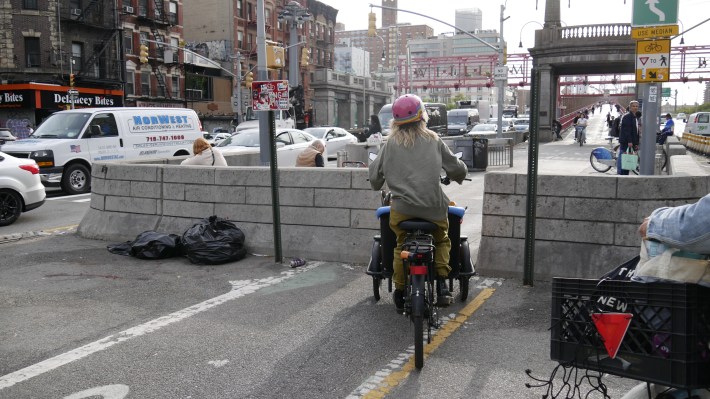
Advocates have pushed for a redesign of the Delancey Street bike lane and its origin at the base of the Williamsburg Bridge for years. DOT put a protected center-running bike lane on the stretch from the base of the bridge to Allen Street in 2019, ahead of an influx of bike commuters expected from the L train shutdown-that-never-was.
The protected bike lane improved safety on the corridor, if not at its terminus. Delancey had nine deaths and 742 injuries between 2006 and 2010 and just one fatality and 397 total injuries between 2018 and 2022, according to data compiled by NYC Crash Mapper.
Even though disgraced ex-Gov. Andrew Cuomo put the kibosh on the L shutdown, bike traffic over the bridge still surged — by 49 percent from June 2019 to June of 2024.
In February 2023, the city announced over $18 million in federal funding through the “Safe Streets And Roads For All” grant program to redesign the Delancey Street median, bike lane and the bridge’s entrance and exit point, but there won't be a ribbon-cutting until 2029 (at the earliest). Advocates think that it's too long to wait to fix the obvious flaws:
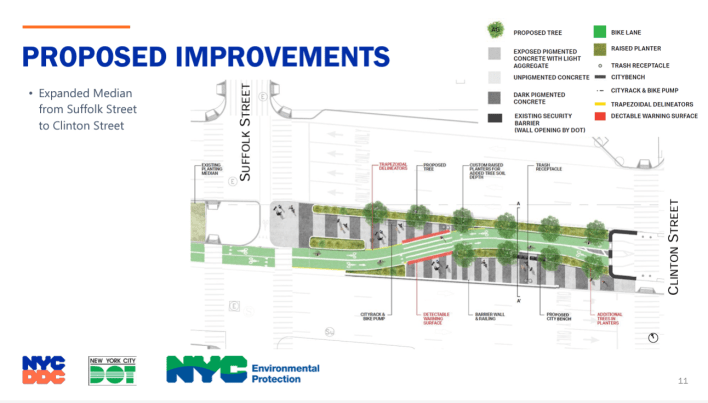
Advocates loathe the extended wait to fix an obvious and urgent problem.
"A 'mess' would put it mildly," said Transportation Alternatives spokesperson Jacob deCastro, who commutes over the Williamsburg Bridge. "Having to wait another five years to get these improvements is not great. I hope to see the city find a way to speed that timeline up or to offer mitigation to fix the conflict points."
